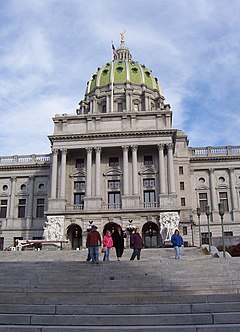Pennsylvania State Capitol
| Pennsylvania State Capitol | |
|---|---|

West side with grand staircase
|
|
| General information | |
| Architectural style | Beaux-Arts, Renaissance Revival |
| Location | 3rd and State Streets Harrisburg, Pennsylvania United States |
| Coordinates | 40°15′52″N 76°53′01″W / 40.264441°N 76.883624°WCoordinates: 40°15′52″N 76°53′01″W / 40.264441°N 76.883624°W |
| Construction started | November 7, 1902 |
| Completed | August 15, 1906 |
| Inaugurated | October 4, 1906 |
| Cost | $13 million |
| Client | Commonwealth of Pennsylvania |
| Owner | Commonwealth of Pennsylvania |
| Height | 272 ft (83 m) |
| Technical details | |
| Floor area | 629,898 sq ft (58,519 m2) |
| Design and construction | |
| Architect | Joseph Miller Huston |
| Official name | State Capitol Building, Pennsylvania |
| Designated | September 14, 1977 |
| Reference no. | 77001162 |
| Designated | September 20, 2006 |
| Designated | February 27, 2013 |
| Part of | Pennsylvania State Capitol Complex |
| Reference no. | 13000287 |
The Pennsylvania State Capitol is the seat of government for the U.S. state of Pennsylvania and is in downtown Harrisburg. It was designed by architect, Joseph Miller Huston in 1902 in a Beaux-Arts style with decorative Renaissance themes throughout. The capitol houses the legislative chambers for the Pennsylvania General Assembly, made up of the House of Representatives and the Senate, and the Harrisburg chambers for the Supreme and Superior Courts of Pennsylvania, as well as the offices of the Governor and the Lieutenant Governor. It is also the main building of the Pennsylvania State Capitol Complex.
The seat of government for the state was originally in Philadelphia, then was relocated to Lancaster in 1799 and finally to Harrisburg in 1812. The current capitol, known as the Huston Capitol, is the third state capitol building to be built in Harrisburg. The first, the Hills Capitol, was destroyed in 1897 by a fire and the second, the Cobb Capitol, was left unfinished when funding was discontinued in 1899.
President Theodore Roosevelt attended the buildings dedication in 1906. After its completion, the capitol project was the subject of a graft scandal. The construction and subsequent furnishing cost three times more than the General Assembly had appropriated for the design and construction; architect, Joseph Huston and four others were convicted of graft for price gouging.
...
Wikipedia
